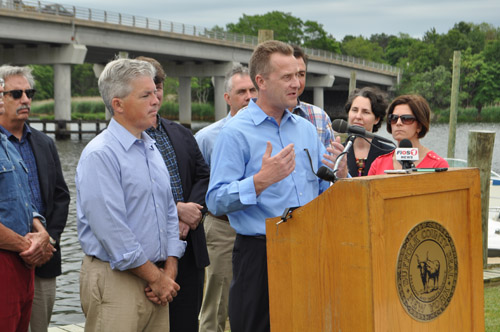Lawmakers call for additional resources to help combat fish kills


Their backs facing the mouth of the Peconic River, town and county officials gathered outdoors Saturday for a press conference at the Riverhead Yacht Club, where they called upon the federal government to provide financial assistance to help address water quality issues in the wake of two fish kills.
“We’re here today to reach out to our federal partners, who have done a tremendous job in recognizing the importance of the Peconic Estuary to our region, and to our nation, by declaring this an estuary of national significance,” said Suffolk County Executive Steve Bellone, who led the conference. “But it is clear, with these two fish kills that have occurred, that we need additional resources to protect this national treasure.”
Since late May, thousands of dead fish have washed up along the shores of the Peconic Estuary in two separate die-offs. These events, Mr. Bellone said, are a “stark reminder” of Long Island’s water quality crisis.
“We are at an ecological tipping point,” said the county executive, who was joined at the press conference by local lawmakers including Riverhead Town Supervisor Sean Walter and Suffolk County Legislator Al Krupski (D-Cutchogue).
According to experts like Stony Brook University biologist Christopher Gobler, the kills were due to low oxygen levels in nearby waters caused by an algae bloom. The bloom was likely fed by nitrogen runoff, Mr. Gobler previously told the News-Review.
Recently, Mr. Walter said, more than five tons of dead fish were recovered from area waters and buried at the town landfill.
Noting that water quality is a $9 billion issue in Suffolk County, Mr. Bellone said Saturday that he would take “as much money” as the federal government would dole out to help solve the crisis.
“All of us together are working so hard to come up with very targeted investments so that we’re getting the biggest nitrogen reduction for the investment that we’re making,” Mr. Bellone said.
Efforts to address water quality in Riverhead Town include plans to upgrade the local sewage treatment plant, which would enable nitrogen loading to be reduced by “probably 70 percent of what our permit standards are now,” Mr. Walter said. He also hopes to upgrade the sewage treatment center in Calverton.
This year’s state budget includes $5 million in funding to create The Long Island Nitrogen Mitigation Plan, a comprehensive strategy for mitigating nitrogen pollution in Suffolk and Nassau county waterways.
Mr. Walter, who, like Mr. Bellone and Mr. Krupski, is up for re-election in November, said he also hopes to help tackle nitrogen overloading by eventually hooking Peconic Bay Boulevard up to a sewer system.
“It’s time,” he said. “We can’t continue to do what we’re doing. We can’t wait, we can’t point fingers. I’m not an engineer, but if we could do that one simple thing I’m venturing a guess that we’re going to pull a tremendous amount of nitrogen out of the estuary.”
The supervisor also urges residents with waterfront properties to never fertilize their lawns, saying that nitrogen runoff from those products empties into the estuary once it rains.
“It’s almost insulting to me that someone would go out to Home Depot or Walmart and buy a bag of fertilizer and fertilize this,” he said, gesturing to a grassy area at the Riverhead Yacht Club. “So to all residents of Riverhead — and I’m sure some of them are not going to be happy with this — please, we implore you: if you have waterfront property, don’t fertilize it. Your neighbors are not going to care if it’s a little brown.”
The New York State Department of Environmental Conservation is working with the Suffolk County Department of Health to investigate the recent fish kills, said Jim Gilmore, head of the New York State Marine Bureau. A report should be issued in about two weeks, he said.







